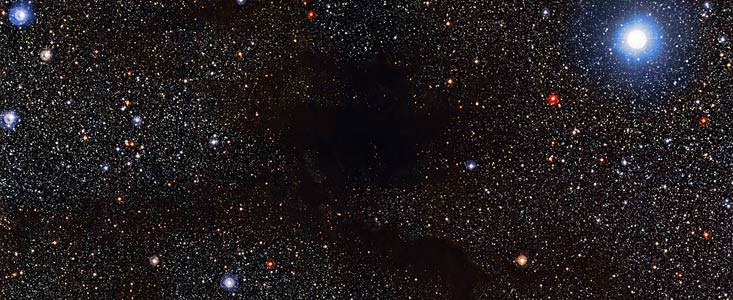Persbericht
Kosmisch weerbericht: na donkere wolken komt zonneschijn
3 september 2014
Lupus 4, een spinvormige klodder van gas en stof, steekt op deze intrigerende nieuwe opname donker af tegen de achtergrondsterren, zoals een donkere wolk tijdens een maanloze nacht. Maar er gloort hoop in de duisternis: uit dichte concentraties van materiaal in wolken als Lupus 4 worden helder stralende nieuwe sterren geboren. De nieuwe foto is gemaakt met de Wide Field Imager van de 2,2-meter MPG/ESO-telescoop van de ESO-sterrenwacht op La Silla (Chili).
Lupus 4 bevindt zich ongeveer 400 lichtjaar van de aarde, in het grensgebied van de sterrenbeelden Lupus (Wolf) en Norma (Winkelhaak). De wolk maakt deel uit van een complex van donkere wolken in een losse verzameling van sterren die de Scorpius–Centaurus OB-associatie wordt genoemd. Een OB-associatie is een relatief jonge, maar wijd verspreide samenscholing van sterren [1]. De sterren zijn waarschijnlijk uit een en dezelfde reusachtige materiewolk ontstaan.
Omdat deze associatie en zijn Lupus-wolken de meest nabije in hun soort zijn, zijn ze een belangrijk doelwit voor het onderzoek naar de manier waarop sterren gezamenlijk opgroeien. Vermoed wordt dat ook onze zon, net als de meeste andere sterren in ons Melkwegstelsel, in zo’n omgeving is ontstaan.
De oudste beschrijvingen van de donkere Lupus-wolken, uit 1927, staan op naam van de Amerikaanse astronoom Edward Emerson Barnard. Dankzij de aanwezigheid van een veertigtal jonge sterren die de afgelopen drie miljoen jaar zijn ontstaan, en op het punt staan om hun fusie-ovens op te starten (eso1303), is Lupus 3, die naast Lupus 4 ligt, het best onderzicht. De belangrijkste energiebron van deze sterren-in-wording, die T Tauri-sterren worden genoemd, is de warmte die vrijkomt doordat ze onder invloed van de zwaartekracht samentrekken. Bij volwassen sterren zoals onze zon is dat anders: hun energie is afkomstig van de fusie van waterstof en andere elementen.
Waarnemingen van de koude duisternis van Lupus 4 hebben slechts een paar T Tauri-sterren opgeleverd. Maar de toekomst van de stervorming in Lupus 4 ziet er niet somber uit: in de wolk bevindt zich een dichte, sterloze kern van materiaal. Binnen enkele miljoenen jaren zal ook deze kern zich ontwikkelen tot T Tauri-sterren. Daaruit kunnen we afleiden dat Lupus 4 wat jonger is dan Lupus 3, die blijkbaar meer tijd heeft gehad om sterren te ontwikkelen.
Hoeveel sterren er uiteindelijk in Lupus 4 zullen stralen? Dat laat zich moeilijk voorspellen, omdat de massa-schattingen van Lupus 4 sterk uiteenlopen. Twee onderzoeken komen uit op ongeveer 250 maal de massa van de zon. Op basis van een andere methode komt een derde onderzoek echter uit op ongeveer 1600 zonsmassa’s. Hoe dan ook bevat de wolk ruimschoots voldoende materiaal om de vorming van vele heldere nieuwe sterren mogelijk te maken. De toekomst van deze kosmische donkere wolk ziet er dus beslist zonnig uit.
Noten
[1] De letters ‘OB’ verwijzen naar de hete, heldere, kort levende sterren van spectraaltypen O en B die nog deel uitmaken van deze wijd verspreide verzameling sterren.
Meer informatie
ESO is the foremost intergovernmental astronomy organisation in Europe and the world’s most productive ground-based astronomical observatory by far. It is supported by 15 countries: Austria, Belgium, Brazil, Czechia, Denmark, France, Finland, Germany, Italy, the Netherlands, Portugal, Spain, Sweden, Switzerland and the United Kingdom. ESO carries out an ambitious programme focused on the design, construction and operation of powerful ground-based observing facilities enabling astronomers to make important scientific discoveries. ESO also plays a leading role in promoting and organising cooperation in astronomical research. ESO operates three unique world-class observing sites in Chile: La Silla, Paranal and Chajnantor. At Paranal, ESO operates the Very Large Telescope, the world’s most advanced visible-light astronomical observatory and two survey telescopes. VISTA works in the infrared and is the world’s largest survey telescope and the VLT Survey Telescope is the largest telescope designed to exclusively survey the skies in visible light. ESO is the European partner of a revolutionary astronomical telescope ALMA, the largest astronomical project in existence. ESO is currently planning the 39-metre European Extremely Large optical/near-infrared Telescope, the E-ELT, which will become “the world’s biggest eye on the sky”.
Links
- Foto’s van de 2,2-meter MPG/ESO-telescoop
- Andere foto’s die met de 2,2-meter MPG/ESO-telescoop zijn gemaakt
- Foto’s van La Silla
Contact
Richard Hook
ESO education and Public Outreach Department
Garching bei München, Germany
Tel: +49 89 3200 6655
Mobiel: +49 151 1537 3591
E-mail: rhook@eso.org
Marieke Baan (Perscontact Nederland)
ESO Science Outreach Network
en NOVA Informatie Centrum
Tel: +31(0)20-5257480
E-mail: eson-netherlands@eso.org
Over dit bericht
| Persberichten nr.: | eso1427nl |
| Naam: | Lupus 4 |
| Type: | Milky Way : Nebula : Appearance : Dark |
| Facility: | MPG/ESO 2.2-metre telescope |
| Instruments: | WFI |
Our use of Cookies
We use cookies that are essential for accessing our websites and using our services. We also use cookies to analyse, measure and improve our websites’ performance, to enable content sharing via social media and to display media content hosted on third-party platforms.
ESO Cookies Policy
The European Organisation for Astronomical Research in the Southern Hemisphere (ESO) is the pre-eminent intergovernmental science and technology organisation in astronomy. It carries out an ambitious programme focused on the design, construction and operation of powerful ground-based observing facilities for astronomy.
This Cookies Policy is intended to provide clarity by outlining the cookies used on the ESO public websites, their functions, the options you have for controlling them, and the ways you can contact us for additional details.
What are cookies?
Cookies are small pieces of data stored on your device by websites you visit. They serve various purposes, such as remembering login credentials and preferences and enhance your browsing experience.
Categories of cookies we use
Essential cookies (always active): These cookies are strictly necessary for the proper functioning of our website. Without these cookies, the website cannot operate correctly, and certain services, such as logging in or accessing secure areas, may not be available; because they are essential for the website’s operation, they cannot be disabled.
Functional Cookies: These cookies enhance your browsing experience by enabling additional features and personalization, such as remembering your preferences and settings. While not strictly necessary for the website to function, they improve usability and convenience; these cookies are only placed if you provide your consent.
Analytics cookies: These cookies collect information about how visitors interact with our website, such as which pages are visited most often and how users navigate the site. This data helps us improve website performance, optimize content, and enhance the user experience; these cookies are only placed if you provide your consent. We use the following analytics cookies.
Matomo Cookies:
This website uses Matomo (formerly Piwik), an open source software which enables the statistical analysis of website visits. Matomo uses cookies (text files) which are saved on your computer and which allow us to analyze how you use our website. The website user information generated by the cookies will only be saved on the servers of our IT Department. We use this information to analyze www.eso.org visits and to prepare reports on website activities. These data will not be disclosed to third parties.
On behalf of ESO, Matomo will use this information for the purpose of evaluating your use of the website, compiling reports on website activity and providing other services relating to website activity and internet usage.
Matomo cookies settings:
Additional Third-party cookies on ESO websites: some of our pages display content from external providers, e.g. YouTube.
Such third-party services are outside of ESO control and may, at any time, change their terms of service, use of cookies, etc.
YouTube: Some videos on the ESO website are embedded from ESO’s official YouTube channel. We have enabled YouTube’s privacy-enhanced mode, meaning that no cookies are set unless the user actively clicks on the video to play it. Additionally, in this mode, YouTube does not store any personally identifiable cookie data for embedded video playbacks. For more details, please refer to YouTube’s embedding videos information page.
Cookies can also be classified based on the following elements.
Regarding the domain, there are:
- First-party cookies, set by the website you are currently visiting. They are stored by the same domain that you are browsing and are used to enhance your experience on that site;
- Third-party cookies, set by a domain other than the one you are currently visiting.
As for their duration, cookies can be:
- Browser-session cookies, which are deleted when the user closes the browser;
- Stored cookies, which stay on the user's device for a predetermined period of time.
How to manage cookies
Cookie settings: You can modify your cookie choices for the ESO webpages at any time by clicking on the link Cookie settings at the bottom of any page.
In your browser: If you wish to delete cookies or instruct your browser to delete or block cookies by default, please visit the help pages of your browser:
Please be aware that if you delete or decline cookies, certain functionalities of our website may be not be available and your browsing experience may be affected.
You can set most browsers to prevent any cookies being placed on your device, but you may then have to manually adjust some preferences every time you visit a site/page. And some services and functionalities may not work properly at all (e.g. profile logging-in, shop check out).
Updates to the ESO Cookies Policy
The ESO Cookies Policy may be subject to future updates, which will be made available on this page.
Additional information
For any queries related to cookies, please contact: pdprATesoDOTorg.
As ESO public webpages are managed by our Department of Communication, your questions will be dealt with the support of the said Department.






